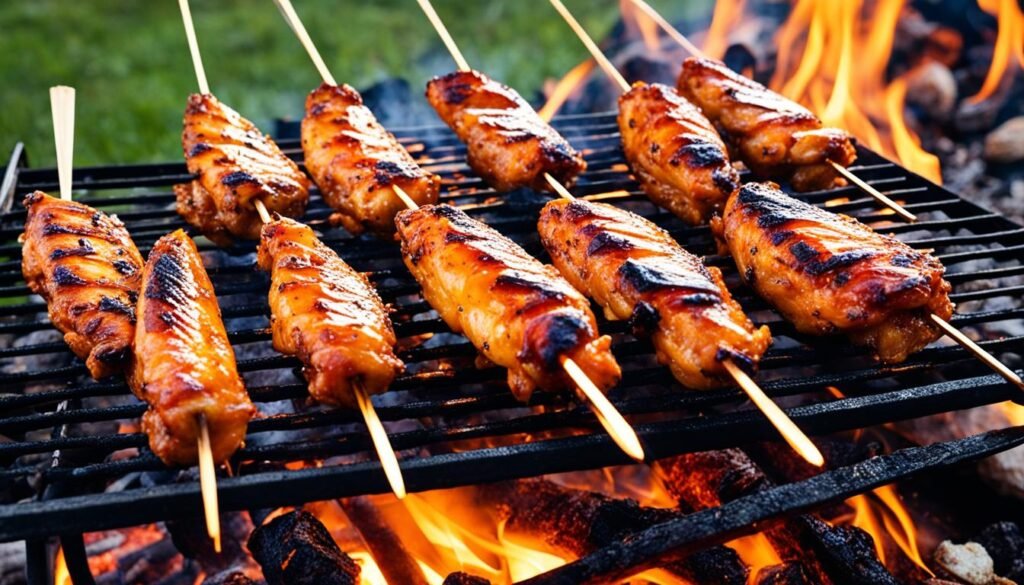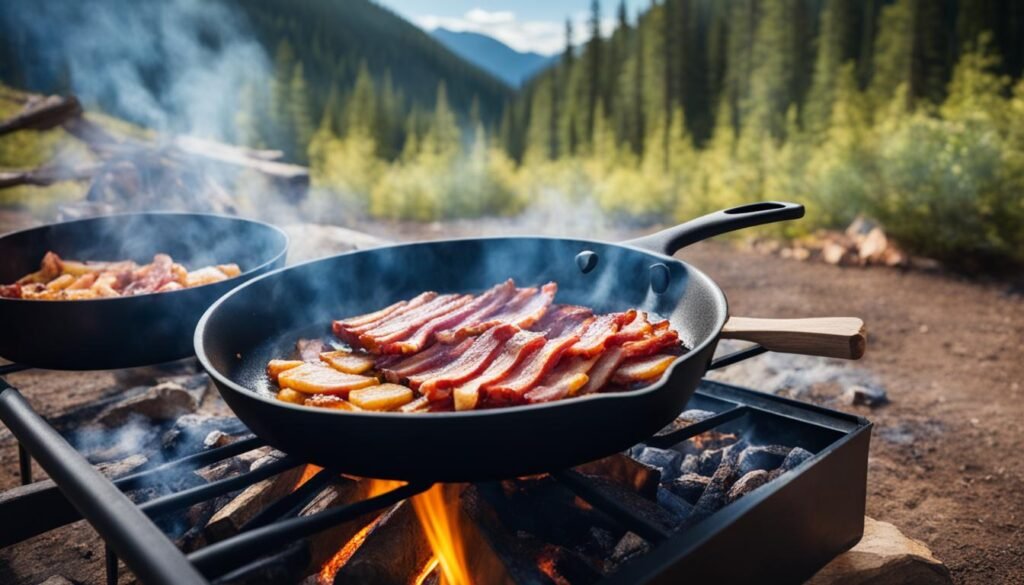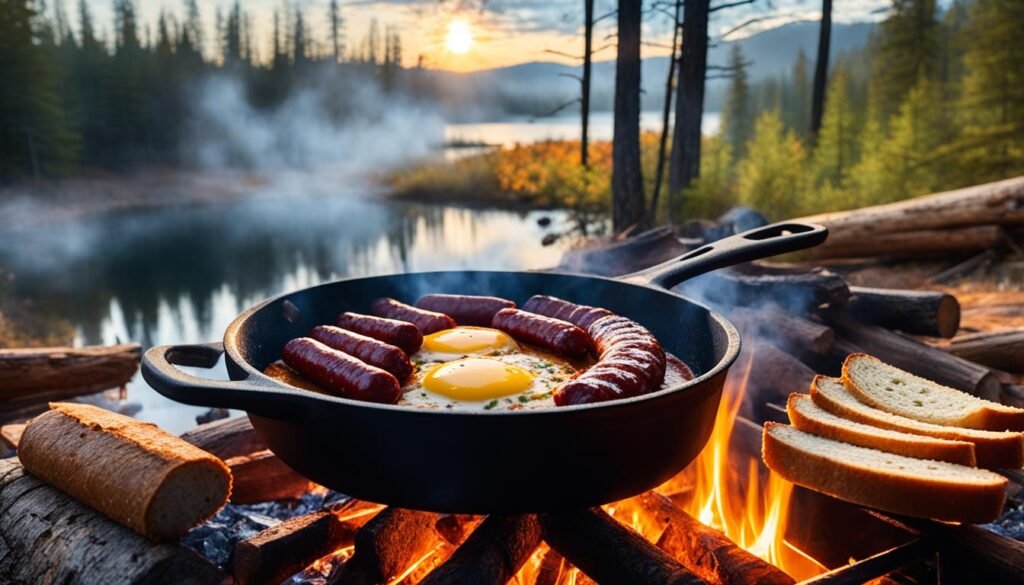Whether you’re a beginner or an experienced outdoor chef, this guide is here to help you master the art of cooking over a campfire. There’s something magical about gathering around a crackling fire, immersing yourself in nature’s embrace, and indulging in mouthwatering meals cooked over an open flame.
Campfire cooking offers a unique sensory experience that you won’t find in a traditional kitchen. The smoky aroma, the gentle sizzling sound, and the deep connection with nature create a truly unforgettable culinary adventure. In this guide, I’ll walk you through all the essential steps, techniques, tools, and recipes you need to know to create delicious meals in the great outdoors.
- Learn how to build the perfect campfire with safety tips and techniques.
- Discover the essential campfire cooking tools you’ll need for a successful outdoor cooking experience.
- Explore various campfire cooking techniques like direct cooking, Dutch oven cooking, and skillet cooking.
- Try out easy and delicious campfire recipes that will satisfy your appetite and impress your fellow campers.
- Discover how to set up a lightweight campfire cooking kit for your backpacking or hiking adventures.
Key Takeaways:
- Master the art of cooking over a campfire, whether you’re a beginner or an experienced outdoor chef.
- Immerse yourself in the sensory experience of campfire cooking, from the smoky aroma to the crackling sound.
- Build a safe and efficient campfire using proper techniques and following Leave No Trace principles.
- Equip yourself with essential campfire cooking tools for delicious meals in the great outdoors.
- Explore different cooking techniques and try out easy and delicious campfire recipes.
Building the Perfect Campfire: Tips and Techniques
When it comes to campfire cooking, building the perfect fire is essential. Not only does it provide the necessary heat and ambiance for outdoor cooking, but it also ensures a safe and enjoyable experience. In this section, I will guide you through the tips and techniques to build a campfire that is both efficient and suitable for cooking.
Choosing the Right Spot
Before starting a fire, it’s important to select a suitable location. Look for a spot that is away from overhanging branches, dry leaves, or any other flammable materials. Clear the area of debris and make sure it is on a level surface. This will help prevent accidental sparks and ensure better control over the fire.
Building the Fire
Building a campfire requires three essential components: tinder, kindling, and firewood. Tinder refers to small, dry, and easily ignitable materials such as small twigs, dry leaves, or paper. This acts as the initial fuel to ignite the fire. Next, use kindling, which consists of slightly larger sticks and branches, to help sustain the flames and generate heat. Finally, add firewood, preferably hardwood, to maintain a steady and long-lasting fire for cooking.
Arrange the tinder in a loose and crisscross pattern, leaving enough space for air circulation. Place the kindling on top of the tinder in a teepee shape to allow it to catch fire easily. Once the kindling is burning steadily, gradually add more firewood to the fire, ensuring it is well-spaced to maintain proper airflow.
Fire Safety and Leave No Trace Principles
Fire safety should always be a priority when cooking over a campfire. Have a bucket of water, sand, or a fire extinguisher nearby to quickly douse the flames if necessary. Never leave the fire unattended and ensure it is completely extinguished before leaving the campsite. Always follow the principles of Leave No Trace, which include leaving the area as you found it, properly disposing of ashes, and minimizing the impact on the environment.
“A well-built campfire sets the foundation for a successful outdoor cooking experience. Take the time to choose the right spot, build the fire properly, and prioritize fire safety.” – Outdoor Cooking Enthusiast
| Campfire Cooking Tips | Outdoor Cooking Techniques |
|---|---|
| Choose a suitable location for your campfire, away from flammable materials. | Experiment with different cooking methods such as grilling, roasting, or using a Dutch oven. |
| Use dry tinder, kindling, and hardwood firewood to build a stable and long-lasting fire. | Try foil packet cooking for easy cleanup and convenient meal preparation. |
| Keep a bucket of water or sand nearby for fire safety. | Practice indirect heat cooking for slow and even cooking results. |
| Never leave the fire unattended and properly extinguish it before leaving. | Utilize the heat from the embers for cooking delicate foods like fish or vegetables. |
By following these campfire cooking tips and outdoor cooking techniques, you’ll be well-prepared to create delicious meals over a campfire. Stay tuned for the next section, where we’ll explore the essential tools needed for campfire cooking.
Essential Campfire Cooking Tools
When it comes to campfire cooking, having the right tools can make all the difference. Whether you’re a seasoned outdoor chef or a beginner, having the essential campfire cooking tools on hand will ensure a successful and enjoyable cooking experience. From roasting sticks to Dutch ovens, each tool serves a specific purpose and can elevate your campfire meals to a whole new level of deliciousness.
Roasting Sticks
Roasting sticks are a must-have for any campfire cookout. These long, sturdy sticks allow you to cook hot dogs, marshmallows, and even shish kebabs over the open flames. Look for sticks with heat-resistant handles and prongs that are sharp enough to safely hold your food in place.
Grill Grate
A grill grate is essential for cooking meats, vegetables, and other foods directly over the campfire. It provides a stable surface for even cooking and prevents food from falling into the fire. Opt for a portable and easy-to-clean grate that fits securely over your campfire.
Dutch Oven
A Dutch oven is a versatile piece of cookware that allows you to bake, roast, simmer, and stew your favorite campfire recipes. Its thick walls and tight-fitting lid make it ideal for cooking meals slowly and evenly over the fire. Choose a Dutch oven made of cast iron for durability and excellent heat retention.
Skewers
Skewers are perfect for grilling vegetables, seafood, and bite-sized pieces of meat. They provide a convenient way to cook and flip food without the need for additional tools. Look for skewers that are long enough to keep your hands safely away from the flames and sturdy enough to hold your ingredients securely.
Tongs
Tongs are indispensable for campfire cooking. They allow you to handle hot food, turn meat on the grill, and move coals around the fire. Choose tongs with a good grip and long handles to keep your hands safe from the heat.
Utensils
A set of utensils will make your campfire cooking experience much easier. Include a spatula for flipping burgers and pancakes, a spoon for stirring soups and sauces, and a knife for cutting ingredients. Look for utensils made of heat-resistant materials that are easy to clean and store.
Having these essential campfire cooking tools on hand will ensure that you’re prepared to cook up delicious meals on your next camping adventure. With the right tools, you can create memorable outdoor dining experiences and enjoy the flavors of nature around the campfire.
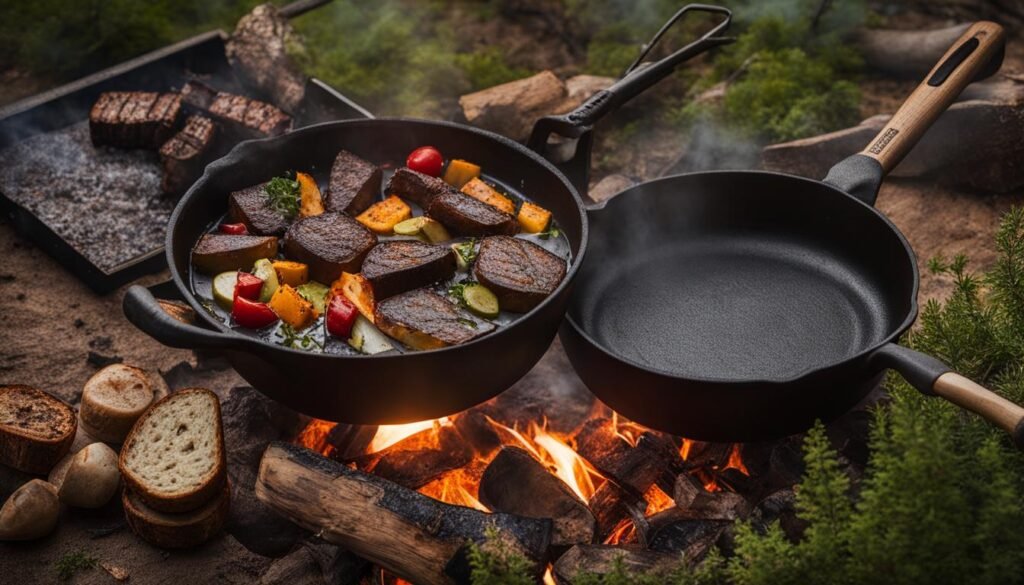
Campfire Cooking Techniques
When it comes to campfire cooking, having a repertoire of techniques at your disposal can elevate your outdoor culinary adventures to new heights. Whether you’re a seasoned outdoor chef or a beginner looking to enhance your cooking skills, mastering different cooking techniques will expand your campfire cooking horizons. In this section, I will explore four popular campfire cooking techniques: direct cooking, foil packets, Dutch oven cooking, and skillet cooking.
1. Direct Cooking
If you prefer a more straightforward approach to campfire cooking, direct cooking is the technique for you. This technique involves placing food directly over the fire for a quick and delicious meal. Whether it’s roasting hot dogs, grilling burgers, or toasting marshmallows for s’mores, direct cooking allows for direct heat exposure, creating a delightful smoky flavor. Just make sure to rotate the food regularly for even cooking.
2. Foil Packets
Foil packets are a versatile and convenient cooking technique for campfire meals. This method involves wrapping food in aluminum foil and placing it on the hot coals or grill grates. Foil packets help retain moisture and flavors while preventing any direct flame contact. You can create a variety of foil packet recipes, including delicious combinations of meats, vegetables, and seasonings. The possibilities are endless!
3. Dutch Oven Cooking
Dutch oven cooking is a classic campfire technique that allows for slow and steady cooking. The Dutch oven is a heavy cast-iron pot with a tight-fitting lid, perfect for baking, braising, and simmering meals over the campfire. From hearty stews and casseroles to freshly baked bread and mouthwatering desserts, the Dutch oven can handle it all. Its thick walls distribute heat evenly, resulting in tender and flavorful dishes.
4. Skillet Cooking
A trusty skillet is a must-have tool for campfire cooking enthusiasts. Whether you opt for a cast-iron or stainless steel skillet, this versatile pan can handle a range of cooking techniques. From searing steaks and sautéing vegetables to making breakfast favorites like pancakes and eggs, skillet cooking over a campfire provides a satisfying and rustic culinary experience.
Each of these campfire cooking techniques offers its unique charm and flavor profile. Depending on your preferences and the ingredients you have on hand, you can choose the technique that best suits your campfire cooking needs. Now, let’s talk about the optimal results you can achieve with these techniques, plus some useful tips!
| Technique | Benefits |
|---|---|
| Direct Cooking |
|
| Foil Packets |
|
| Dutch Oven Cooking |
|
| Skillet Cooking |
|
Easy and Delicious Campfire Recipes
When it comes to camping, one of the highlights is undoubtedly the delicious meals you can cook over a campfire. From hearty main courses to mouthwatering desserts, there are endless possibilities for creating memorable camping meals. In this section, I will share some easy and delicious campfire recipes that are sure to impress your fellow campers and satisfy your taste buds.
Campfire Nachos
Who doesn’t love nachos? This campfire twist on a classic snack is perfect for sharing around the campfire. Start by layering tortilla chips on a cast iron skillet or aluminum foil. Top the chips with shredded cheese, black beans, diced tomatoes, sliced jalapenos, and any other toppings you like. Place the skillet over the campfire or on a grill grate and cook until the cheese is melted and bubbly. Serve with sour cream, guacamole, and salsa for a flavorful camping treat.
Foil Packet Potatoes
For a simple and savory side dish, try these foil packet potatoes. Start by slicing potatoes into thin rounds or cubes. Place the potato slices on a piece of aluminum foil and season with salt, pepper, and your choice of herbs or spices. Add a pat of butter or a drizzle of olive oil to keep the potatoes moist. Fold the foil to create a tightly sealed packet and place it on the campfire or grill. Cook for about 20-30 minutes, or until the potatoes are tender and golden brown. These foil packet potatoes make a delicious complement to any campfire meal.
Campfire Skillet Pizza
Yes, you read that right – pizza cooked over a campfire! This recipe is a fun and delicious way to enjoy a homemade pizza while camping. Start by preheating a cast iron skillet over the fire. Roll out pizza dough and place it in the skillet, pressing it down to cover the bottom. Spread pizza sauce over the dough and add your favorite toppings, such as cheese, pepperoni, mushrooms, and bell peppers. Place a lid or aluminum foil over the skillet to create a mini oven effect and cook for about 10-15 minutes, or until the cheese is melted and bubbly. Slice and enjoy your campfire skillet pizza!
Dutch Oven Chili
Nothing warms you up on a chilly camping night quite like a bowl of hearty chili. This recipe is perfect for cooking in a Dutch oven over the campfire. Start by browning ground beef or turkey in the Dutch oven. Drain any excess fat and add chopped onions, bell peppers, garlic, and your favorite chili seasonings. Stir in canned diced tomatoes, tomato sauce, beans, and a touch of broth or water. Cover the Dutch oven and let the chili simmer over the fire for a couple of hours, stirring occasionally. Serve with shredded cheese, sour cream, and diced onions for a satisfying camping meal.
Creative S’mores Variations
No camping trip is complete without indulging in some gooey, chocolatey s’mores. While the classic combination of graham crackers, chocolate, and marshmallows is always a hit, why not get creative and try some unique variations? Here are a few ideas:
- Swap out the graham crackers for chocolate chip cookies or peanut butter cookies for a decadent twist.
- Add a layer of creamy Nutella or peanut butter to your s’mores for an extra burst of flavor.
- Experiment with different types of chocolate, such as caramel-filled chocolate squares or white chocolate.
- Add sliced bananas, strawberries, or caramelized bacon for an unexpected twist.
Let your imagination run wild and create your own signature s’mores combinations. The possibilities are endless!
With these easy and delicious campfire recipes, you can elevate your outdoor cooking experience and create memorable meals while enjoying the beauty of nature. Whether you’re a seasoned camper or a beginner, these recipes are sure to satisfy your cravings and impress your fellow campers. So grab your ingredients, gather around the campfire, and let the culinary adventures begin!

Setting Up a Lightweight Campfire Cooking Kit
When it comes to backpacking or hiking trips, every ounce matters. That’s why a lightweight campfire cooking kit is essential for outdoor enthusiasts who love to cook delicious meals on their adventures. With the right gear, you can enjoy hot and satisfying meals without compromising on weight or space in your backpack.
Here are some recommendations for lightweight cooking equipment that will make your campfire cooking experience a breeze:
Titanium Cookware
Investing in lightweight titanium cookware can significantly reduce the weight of your cooking kit. Titanium is not only lightweight but also incredibly durable, making it perfect for outdoor use. Look for compact pots, pans, and mugs made from titanium to save weight without sacrificing cooking efficiency.
Collapsible Utensils
To further optimize space in your backpack, consider using collapsible utensils. These innovative utensils are made from lightweight materials like aluminum or stainless steel and can be folded or telescoped for easy storage. They are compact, practical, and perfect for enjoying your campfire meals.
Flexible Cutting Boards
Prepare your ingredients with ease by using flexible cutting boards. These lightweight and flexible cutting boards are made from food-grade plastic and can be rolled or folded for effortless storage. They provide a hygienic surface for chopping, slicing, and dicing your ingredients, allowing you to cook gourmet meals even in the great outdoors.
Lightweight Saws
If you enjoy cooking with fresh firewood, a lightweight saw is a valuable addition to your campfire cooking kit. Look for compact folding saws with sharp blades that can effortlessly cut through branches and small logs. A lightweight saw will allow you to gather firewood easily and efficiently, ensuring you have a steady supply for your campfire cooking needs.
In addition to these essential cooking tools, don’t forget to pack items like firestarters, spices, and utensils. These small but crucial additions will enhance your campfire cooking experience and make it more enjoyable.
Remember, it’s important to strike a balance between lightweight gear and functionality. Choose items that are not only lightweight but also durable and efficient. A well-organized and lightweight campfire cooking kit will enable you to create delicious meals while enjoying the beauty of the great outdoors.
So, next time you embark on a backpacking or hiking adventure, make sure to assemble your lightweight campfire cooking kit for a memorable and satisfying culinary journey.
| Recommended Lightweight Cooking Equipment | Weight | Material |
|---|---|---|
| Titanium Cookware | Varies (typically between 3-10 ounces) | Titanium |
| Collapsible Utensils | 2-5 ounces | Aluminum or Stainless Steel |
| Flexible Cutting Boards | 1-3 ounces | Food-grade Plastic |
| Lightweight Saws | 4-8 ounces | Steel or Carbon Fiber |
Cooking with Cast Iron and Other Heavy-Duty Cookware
When it comes to campfire cooking, using the right cookware can make all the difference. One option that stands out in terms of durability, heat retention, and versatility is cast iron cookware.
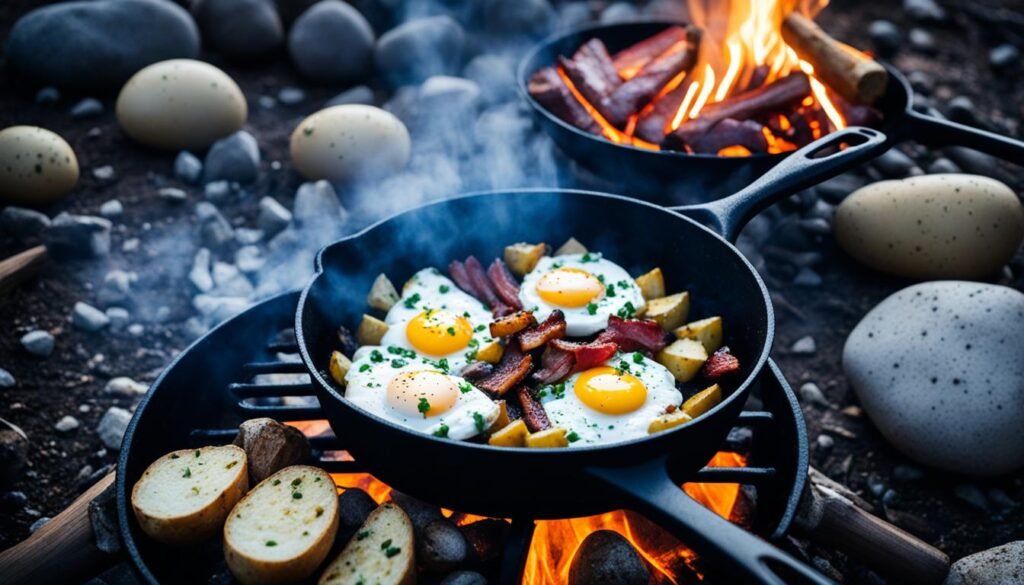
Cast iron cookware is known for its exceptional heat distribution, which allows for even cooking and prevents hot spots. This makes it perfect for preparing a wide range of meals over a campfire. Whether you’re searing a steak, baking cornbread, or simmering a stew, cast iron can handle it all with ease.
- Retains heat: Cast iron retains heat like no other material, ensuring your food stays warm for longer periods. This is especially important for campfire cooking, where maintaining a consistent temperature can be challenging.
- Durable and long-lasting: Cast iron cookware is incredibly durable and built to last. With proper care, it can be passed down through generations of outdoor enthusiasts.
- Versatile: Cast iron skillets and Dutch ovens can be used for a wide variety of cooking methods, from frying and sautéing to baking and braising. Their sturdy construction makes them suitable for use directly on the campfire.
While cast iron is often the go-to choice for campfire cooking, there are other heavy-duty cookware options worth considering as well. Griddles, for example, are excellent for cooking large quantities of food at once, making them ideal for group camping trips. Dutch ovens are another popular choice, especially for slow-cooked dishes and baking delicious desserts.
Investing in high-quality heavy-duty cookware is a smart decision for any outdoor cooking enthusiast. Not only will it enhance your campfire cooking experience, but it will also last for years to come, making it a worthwhile investment.
Campfire Safety Tips
When it comes to cooking over a campfire, safety should always be your top priority. By following a few simple guidelines, you can ensure a safe and enjoyable cooking experience in the great outdoors.
Choosing a Safe Spot
Before you start your campfire, carefully select a safe spot away from any flammable materials, such as dry grass, shrubs, or overhanging branches. Clear the area around the fire pit to create a buffer zone, and make sure it is at least 10 feet away from tents or other structures.
Storing Flammable Materials
- Keep flammable materials, such as lighter fluid and propane tanks, a safe distance from the fire.
- Store them in a cool, dry place away from direct sunlight and open flames.
- Make sure they are tightly sealed to prevent leaks or spills.
Starting and Maintaining a Campfire
- Use dry kindling, such as small sticks and twigs, to start your campfire.
- Avoid using accelerants, like gasoline or kerosene, as they can cause dangerous flare-ups.
- Gradually add larger firewood to build up the flames, and always keep a safe distance.
- Never leave a campfire unattended, and ensure someone responsible is keeping an eye on it at all times.
Extinguishing the Fire Properly
When you’re done cooking, it’s crucial to extinguish the fire completely before leaving the campsite. Follow these steps to ensure the fire is safely put out:
- Allow the remaining wood to burn down to ash.
- Use a shovel or stick to stir the ashes, making sure to extinguish any remaining embers.
- Pour water over the fire, taking care to douse any hotspots.
- Continue stirring the ashes and adding more water until the fire is cold to the touch.
Remember, campfire safety is not only important for your well-being but also for the preservation of our natural environment. By practicing these safety tips, you can enjoy delicious meals and create lasting memories around the campfire, all while minimizing the risk of accidents or damage to the surroundings.
Campfire Cooking Etiquette and Leave No Trace Principles
When embarking on a campfire cooking adventure, it’s essential to not only create delicious meals but also to practice proper etiquette and environmental responsibility. By adhering to campfire cooking etiquette and following Leave No Trace principles, we can ensure that our cooking experiences leave minimal impact on the environment and preserve the beauty of nature for future generations to enjoy.
Campfire Cooking Etiquette
Respecting nature and other campers is paramount when cooking over a campfire. Here are some guidelines to follow:
- Choose existing fire rings whenever possible to minimize the impact on the landscape.
- Do not cut or damage trees or vegetation for firewood or cooking.
- Avoid excessive noise that may disturb wildlife or other campers.
- Keep your cooking area clean and organized, minimizing the spread of debris.
- Dispose of food waste properly, either by packing it out or by using the designated waste receptacles if available.
Leave No Trace Principles
The Leave No Trace principles provide a framework for responsible outdoor recreation. When cooking over a campfire, consider the following:
- Plan ahead and prepare: Understand the regulations and restrictions of the area where you plan to cook. Bring the necessary cooking equipment and consider the availability of firewood.
- Travel and camp on durable surfaces: Choose established fire rings or areas that are already impacted to minimize further damage.
- Dispose of waste properly: Pack out any trash generated during your camping trip, including food packaging and utensils.
- Minimize campfire impacts: Follow fire safety guidelines, use existing fire rings, and keep your fire small. Only burn clean and dry firewood.
- Respect wildlife: Keep your cooking area clean and free of food scraps. Respect wildlife by observing them from a distance and not feeding them.
- Be considerate of other visitors: Keep noise levels to a minimum, especially during quiet hours. Respect the privacy and enjoyment of other campers.
By practicing campfire cooking etiquette and adhering to Leave No Trace principles, we can enjoy the pleasures of outdoor cooking while minimizing our impact on the environment. Together, let’s create memorable meals and preserve the natural beauty of our camping destinations.
Conclusion
Throughout this guide, we have explored the art and joy of campfire cooking. From building the perfect campfire to mastering essential cooking techniques, we have delved into the world of outdoor culinary adventures. Whether you are a beginner or an experienced outdoor chef, campfire cooking offers a unique sensory experience that connects us with nature and brings out our inner food enthusiasts.
By practicing and experimenting with campfire cooking techniques, recipes, and tools, you can elevate your outdoor cooking skills to new heights. The simplicity and rustic charm of campfire cooking can turn a simple meal into a memorable dining experience. Imagine the sizzling sounds, the inviting aromas, and the warm glow of the fire as you cook delicious meals under the open sky.
So, next time you plan a camping trip or a backyard bonfire, embrace the magic of campfire cooking. Gather around the fire, embrace the crackling flames, and let your creativity flow. Discover the joy of preparing mouthwatering campfire recipes, from savory foil packet dishes to indulgent s’mores variations. Explore the versatility of cast iron and other heavy-duty cookware, or go for a lightweight campfire cooking kit for your backpacking adventures.
Campfire cooking not only satisfies our hunger but also feeds our souls. It brings us closer to nature, creates lasting memories, and fosters a deep appreciation for the simple pleasures of outdoor life. So, grab your cooking utensils, gather your loved ones, and let the campfire become your kitchen. Embrace the flavors, the warmth, and the camaraderie that come with cooking on a campfire, and let the experience create moments to cherish for a lifetime.
FAQ
Is campfire cooking suitable for beginners?
Absolutely! Campfire cooking can be enjoyed by both beginners and experienced outdoor chefs. With a little practice and the right techniques, anyone can create delicious meals over a campfire.
What are some essential tips for building a campfire for cooking?
To build a safe and efficient campfire for cooking, choose a suitable spot, gather tinder, kindling, and firewood, and maintain fire safety. Always have a fire extinguishing method available and follow Leave No Trace principles.
What tools do I need for campfire cooking?
Essential campfire cooking tools include roasting sticks, a grill grate, a Dutch oven, skewers, tongs, and utensils. Different types of outdoor cookware, such as cast iron, can also be used for campfire cooking.
What are some popular campfire cooking techniques?
Some popular campfire cooking techniques include direct cooking, foil packets, Dutch oven cooking, and skillet cooking. Each technique offers unique advantages and can be used to prepare a variety of meals.
Can you recommend some easy campfire recipes?
Certainly! Here are a few easy and delicious campfire recipes: campfire nachos, foil packet potatoes, campfire skillet pizza, Dutch oven chili, and creative s’mores variations. Step-by-step instructions and ingredient lists can be found in the recipe section.
What should I pack for a lightweight campfire cooking kit?
For a lightweight campfire cooking kit, consider items like titanium cookware, collapsible utensils, flexible cutting boards, and lightweight saws. Don’t forget essential items like firestarters, spices, and utensils.
Is cooking with cast iron recommended for campfire cooking?
Cooking with cast iron is highly recommended for campfire cooking. Cast iron cookware is durable, retains heat well, and is versatile for various campfire cooking methods. Other heavy-duty cookware options, like griddles and Dutch ovens, are also suitable.
What are some important campfire safety tips?
Some important campfire safety tips include choosing a safe spot, storing flammable materials properly, starting and maintaining a campfire responsibly, and extinguishing the fire correctly. Following safety precautions helps prevent accidents and minimizes environmental impact.
How can I practice campfire cooking etiquette and follow Leave No Trace principles?
To practice campfire cooking etiquette and follow Leave No Trace principles, respect nature, minimize waste, and leave the campsite as pristine as possible. Responsible outdoor cooking helps preserve the environment for future generations.



